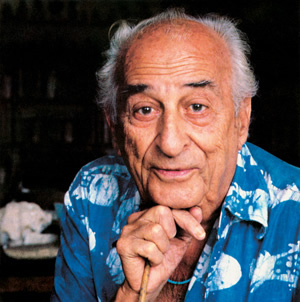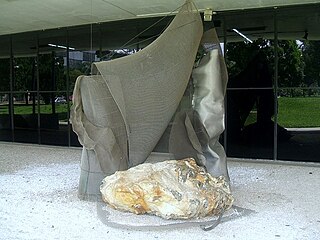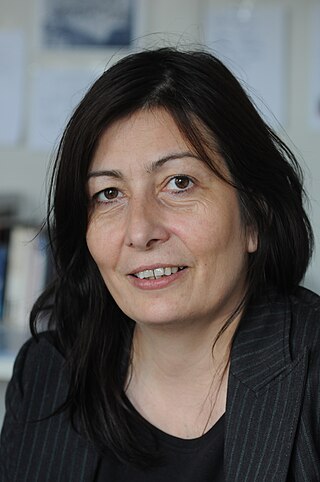Related Research Articles
Lia Mascarenhas Menna Barreto is a Brazilian studio artist currently based in Rio Grande do Sul.

Alfons Hug is a curator, critic and exhibition organizer.

Aleksandra Mir is a Swedish-American contemporary artist known for her large scale collaborative projects and for her anthropological methods, involving rigorous archival research, oral history and field work. Her work deals with travel, time, placehood, language, gender, identity, locality, nationality, globality, mobility, connectivity, performativity, representation, transition, translation and transgression.

Héctor Julio Páride Bernabó was an Argentine-Brazilian artist, researcher, writer, historian and journalist. His nickname and artistic name, Carybé, a type of piranha, comes from his time in the scouts. He died of heart failure after the meeting of a candomblé community's lay board of directors, the Cruz Santa Opô Afonjá Society, of which he was a member.

Gretta Sarfaty, born Alegre Sarfaty, is also known as Gretta Grzywacz and Greta Sarfaty Marchant, also simply as Gretta. is a painter, photographer and multimedia artist who earned international acclaim in the 1970s, from her artistic works related to Body art and Feminism. Born in Greece, in 1947, she moved with her family to São Paulo in 1954, being naturalized as Brazilian.
Maristela Salvatori, is an artist and printmaker. She has a degree in Fine Art from the Universidade Federal do Rio Grande do Sul, Instituto de Artes, where she teaches on the undergraduate and Postgraduate Visual Arts Programme and coordinates research into 0 Fascínio do Traço. She works with issues related to printmaking and photography and is currently head of the Postgraduate Visual Arts Programme. She is a co-author of the book Mestiçagens na Arte Contemporânea.

Marco Maggi is a New York- and Uruguay-based artist whose work incorporates common materials such as office paper, aluminum foil, graphite, and apples to create micro drawings, sculptures, and macro installations.

Martha Medeiros is a Brazilian writer and journalist. She works as columnist of the Zero Hora and O Globo newspapers.

Eduardo Navarro is a contemporary Argentinian artist. He lives and works in Buenos Aires, Argentina. Since 2002, he has worked in a variety of mediums, including sculpture, collage, performance and installation.

Iole Antunes de Freitas is a Brazilian sculptor, engraver, and installation artist who works in the field of contemporary art. Freitas began her career in the 1970s, participating in a group of artists in Milan, Italy linked to Body art. She used photography. In the 1980s, she returned to Brazil, but abandoned the human body as mediator of her work, adopting the "sculpture body". The artist uses materials such as wire, canvas, steel, copper, stone, and water to create her works.
Guilherme Dable is a Brazilian artist who lives and works in Porto Alegre. He had his MFA from Universidade Federal do Rio Grande do Sul Art Institute in 2012, having graduated there in drawing in 2009. Guilherme Dable’s films The Tamer and The radio was always on in the kitchen are part of Museum of Modern Art, Rio de Janeiro’s permanent collection, 2016. Guilherme also has paintings in the above-mentioned collection on permanent loan from Gilberto Chateaubriand.
Dudi Maia Rosa is a Brazilian artist.
Márcia Pinheiro de Oliveira was a Brazilian performer and visual artist. Her performances, videos and installations deal with themes of sexuality, eroticism, consumerism, childhood and religion, often using sex toys, children's toys and religious artifacts.
Lenora de Barros is a Brazilian artist and poet. She studied linguistics at the University of São Paulo before establishing her artistic practice during the 1970s, and has remained committed to the exploration of language through a variety of media, including video, performance, photography and installation.

Instituto Itaú Cultural is a Brazilian not-for-profit cultural institute owned by Itaú Unibanco. The institute was founded by Olavo Egydio Setúbal and created under the Law nº 7505, of 3 October 1986. The institute's goal is to map artistic manifestations and to foster artistic research and production related to all cultural sections.
Vera Chaves Barcellos is a Brazilian artist and educator. She was featured in the Radical Women show at the Brooklyn Museum in 2018.
Arissana Pataxó is the pen name used by Arissana Braz, a Brazilian visual artist and educator.
Mara Alvares is a Brazilian artist. She mainly specialized in photography as one of her notable works is the Adansônia. She first studied metal engraving with the Universidade Federal do Rio Grande do Sul with Iberê Camargo.
Silvia Rivas is an Argentine visual artist known for her multi-channel video installations. In Latin America she is considered a precursor in the area of expanded video. Her work is characterized by the crossing of materialities and technologies in which she uses both electronic devices and ancestral techniques. Her production is organized in thematic series of video installations, drawings, photographs or objects. Interested in revealing the metaphorical power of different materialities, she uses the electronic medium and the moving image to record stillness, the imminent and the subjective perception of time.

Ingrid Paula del Carmen Wildi-Merino is a Chilean-born Swiss video artist, curator, and educator. She has been a lecturer at the Geneva University of Art and Design, from 2005 to 2016. She has been active in Geneva, Biel, and Madrid; and she currently lives in Santiago.
References
- ↑ "Marina Camargo". Artsy. Retrieved 8 September 2021.
- ↑ Ammilhat Szaryl, Anne-Laure (2014). Placing the Border in Everyday Life (1st ed.). England / USA: Ashgate Publishers. pp. 215–216. ISBN 978-1-4724-2454-9.
- ↑ "Marina Camargo – Planned City (Sao Paulo), 2014". www.itaucultural.org.br (in Brazilian Portuguese). Retrieved 20 March 2018.
- ↑ Prikladnicki, Fábio (7 October 2013). "Marina Camargo expõe a impossibilidade da representação em mostra individual". Zero Hora. Zero Hora. Retrieved 17 February 2016.
- ↑ Dasartes, Artes Visuais em Revista (28 February 2012). Brazil art guide (2nd ed.). Indexa. p. 166. ISBN 978-85-60138-06-7.
- ↑ Ammilhat Szaryl, Anne-Laure (2014). Placing the Border in Everyday Life (1st ed.). England / USA: Ashgate Publishers. ISBN 978-1-4724-2454-9.
- ↑ "8 Bienal do Mercosul" (PDF). cadernodevoyage3.files.wordpress.com (in Brazilian Portuguese). September 2012.
- ↑ Camargo, Marina (17 February 2016). "Como se faz um deserto". official website.
- ↑ CAMARGO, Marina (2013). Como se faz um deserto (1st ed.). Porto Alegre. ISBN 978-85-916613-0-5.
{{cite book}}: CS1 maint: location missing publisher (link) - ↑ "Pipa Prize". Pipa Prize – The window into Brazilian Contemporary Art. Retrieved 25 July 2016.
- ↑ "PIPA Prize" . Retrieved 4 September 2017.